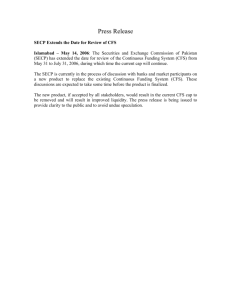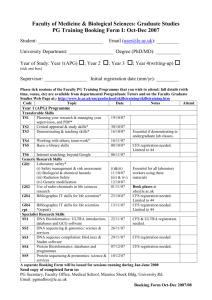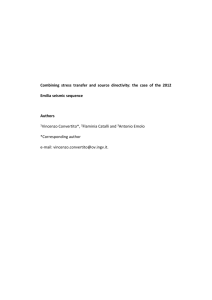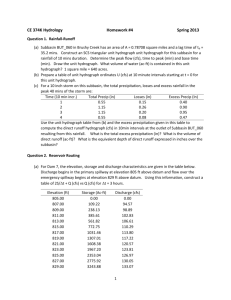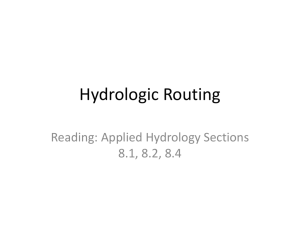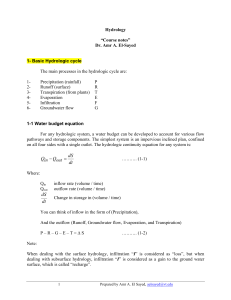Sample questions for Final Exam
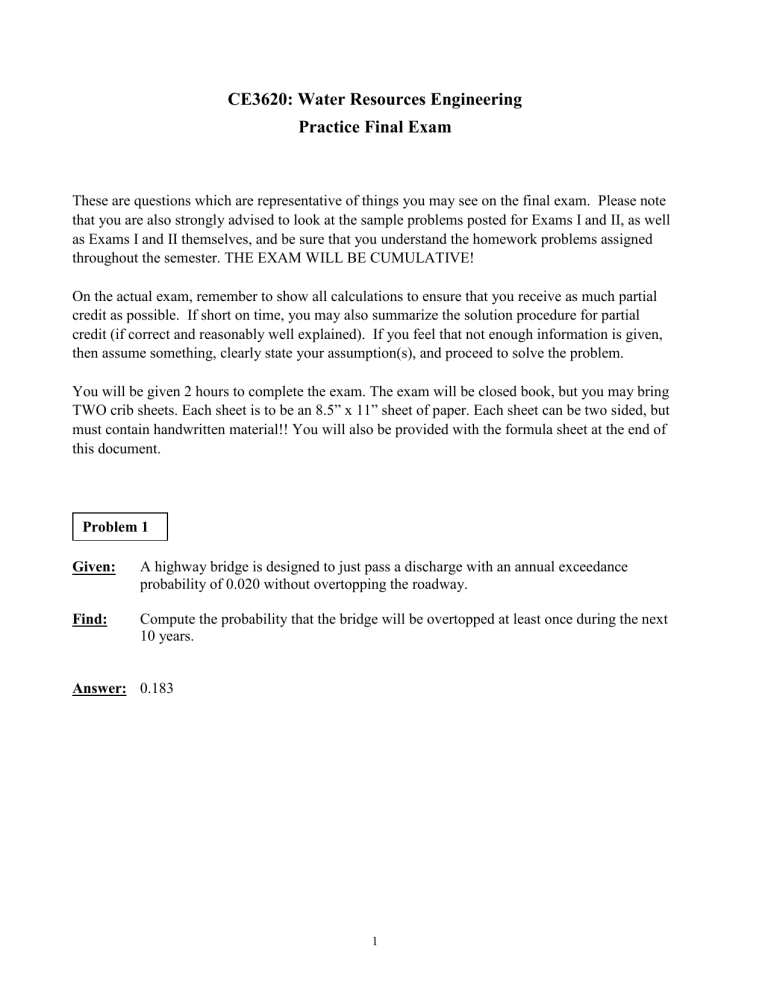
CE3620: Water Resources Engineering
Practice Final Exam
These are questions which are representative of things you may see on the final exam. Please note that you are also strongly advised to look at the sample problems posted for Exams I and II, as well as Exams I and II themselves, and be sure that you understand the homework problems assigned throughout the semester. THE EXAM WILL BE CUMULATIVE!
On the actual exam, remember to show all calculations to ensure that you receive as much partial credit as possible. If short on time, you may also summarize the solution procedure for partial credit (if correct and reasonably well explained). If you feel that not enough information is given, then assume something, clearly state your assumption(s), and proceed to solve the problem.
You will be given 2 hours to complete the exam. The exam will be closed book, but you may bring
TWO crib sheets. Each sheet is to be an 8.5” x 11” sheet of paper. Each sheet can be two sided, but must contain handwritten material!! You will also be provided with the formula sheet at the end of this document.
Problem 1
Given: A highway bridge is designed to just pass a discharge with an annual exceedance probability of 0.020 without overtopping the roadway.
Find: Compute the probability that the bridge will be overtopped at least once during the next
10 years.
Answer: 0.183
1
Problem 2
Given: A stream bed has a rectangular cross section 5 meters wide and a slope of .0002 m/m.
The flow rate in the stream is 8.75 m
3
/s. A dam is built across the stream, causing the water surface to rise to 2.5 meters just upstream of the dam, as shown below.
Assume n = .015.
y
≈ y n
2.5 m
Find: (a) Find the normal depth, y n
, corresponding to this flow rate and channel geometry.
Ans.
y n
= 1.8 m
(b) Find the critical depth, y c
.
Ans.
y c
= 0.678 m
(c) Identify the water surface profile upstream of the dam. Explain your answer for full credit.
Ans.
M1 profile.
(d) Briefly explain (or list the steps) how you would compute the water surface profile
(depth vs. distance along the channel).
Ans.
Discuss steps of Direct-Step method.
2
Problem 3
Given: An upstream hydrograph is shown below in Figure 1.
Q max
= 600 cfs
Q
0 3 10 t (hrs)
Figure 1. Upstream (inflow) hydrograph.
Find: Route the upstream hydrograph to a location downstream using the Muskingum method with K = 0.4 hr, X = 0.2, and
Δ t = 0.5 hr. Assume that the initial flow downstream is zero. You only need to compute the first three ordinates of the downstream hydrograph
(from time 0 to 3
Δ t ).
Answer:
Time
(hrs)
Inflow
(cfs)
Outflow
(cfs)
0
0.5
1.0
1.5
0
100
0
29.8
200 121.2
300 220.1
3
Problem 4
Given: The outflow rate (cfs) and storage (cfs-hr) for an emergency spillway of a certain reservoir are linearly related by O = S /3, where the number 3 has units of hours.
Find: Use storage-outflow relationship O = S /3 and the continuity equation
S
2
+
O
2
2
∆ t
=
( I
1
+
2
I
2
)
∆ t
+ −
1
O t
1
∆
2 to determine the peak outflow rate from the reservoir for the following event:
Time
(hr)
I
(cfs)
S
(cfs-hr)
O
(cfs)
0
2
0
400
0 0
4
6
8
600
200
0
Answer: Peak outflow is 350 cfs.
Time
(hr)
0
2
4
6
8
I
(cfs)
0
400
600
200
0
S
(cfs-hr)
0
300
900
1050
675
O
(cfs)
0
100
300
350
225
4
Problem 5
Given: A 400-acre watershed is to be developed into an industrial district with an estimated
NRCS Curve Number of 90. The distance from the watershed divide to the outlet is 3800 ft, and the average watershed slope is 75 ft/mile (0.0142 ft/ft).
Find: (a) Compute the hourly runoff depth from a 2-hour, 4-inch rainfall event assuming the rainfall occurs at a uniform rate (2 in/hr for 2 hrs).
Ans.
Time
ΔV
R
(hrs) (in)
0 0
1
2
1.09
1.83
(b) Compute basin lag time t
L
(hours), time to peak T
P
, and the peak unit hydrograph discharge Q
P
(ft
3
/s), and sketch the 1-hr NRCS triangular unit hydrograph for the watershed.
Ans.
t
L
= 0.545 hrs; T
P
= 1.045 hrs; Q
P
= 289.5 cfs; T
B
= 2.79 hrs
Discharge
(cfs) 150
100
50
0
350
300
250
200
0 1
Time (hours)
2 3
5
(c) Estimate the peak discharge (ft
3
/s) from the 4-inch rainfall event assuming that the rainfall occurs uniformly over a 2-hour period (2.0 in/hr). Use a 1-hour time interval for your calculations.
Ans.
Time UH Flow Excess Precipitation (in) Runoff
(hrs) (cfs) 1.09 1.82 (cfs)
0
1
2
3
4
0
277.0
130.8
0
0
0
301.9
142.5
0
0
0
504.2
238.0
0
0
301.9
646.7
238.0
0
(d) Based on the attached rainfall intensity-duration-frequency curve, what is the return period of this 2-hour storm?
Ans.
T = 10 years
6
7
EQUATIONS AND CONVERSION FACTORS
∑
F x
= βρ
(
2
−
V
1
)
Q
=
N A
2 gH
L
K en
+
K f
+
1
P
γ
1 z
α
V
1
2
2 g
+
E p
=
P
γ
2
+ z
2
+
α
V
2
2
2 g
+
H
L
+
H
M
Q
=
N A C p e o
2 (
−
D / 2) x
=
− ± b
2 −
4 ac
2 a
Q = VA y
1 z
1
V
1
2g
2
= y
2
+ z
2
+
V
2
2g
2
+
H
L dE dy
=
1
−
Q
2 gA
3 dA dy
Q
=
C m n
AR 2 / 3 S o
1/ 2 dy dx
=
S o
−
S
1
−
Fr
2 f
Fr
=
V gD y
2
= y
2
1
(
1 1 8Fr
1
2
)
H
L
= f
L V
2
P water
= γQE p
H
M
=
K
V
2
2 g
P shaft
= P water
/
η
H
L
=
2 2 n V L
2 4/3
C R m
A = y(B + SSy) P
= + + 2 T = B + 2ySS
A = By P = B + 2y
R = A/P Q = CiA
D = A/T i
= a
( t
+ b ) c
T
B
= 2.667
T p
T
P
= D/2 + t
L
Q
P
= 484 A / T
P t
L
= l
0.8
(1000
−
9 CN )
0.7
1900 CN
0.7
Y
0.5
V
R
=
( P
−
0.2
S )
2
P
+
0.8
S
I
A
= 0.2S
S
=
[
+ −
) ]
C
1
=
0.5
t Kx
K
−
Kx
+
0.5
∆ t
1 mile = 5280 ft
1 acre = 43,560 ft
2 g = 32.2 ft/s
2
= 9.81 m/s
2
T
B
= 5 T p
Q
P
= 2.08
A / T
P t
L
= l
0.8
(2540 22.86
CN )
0.7
1410 CN Y
0.5
S
=
2540
CN
−
25.4
R = 1 – (1 – P)
N
O t+1
= C
1
I t+1
+ C
2
I t
+ C
3
O t
C
2
=
0.5
t Kx
K
−
Kx
+
0.5
∆ t
1 inch = 2.54 cm
1 mi
2
= 640 acres
γ
= 62.4 lb/ft
3
= 9.79 kN/m
3 t
C
=
5
3 t
L
S
=
1000
CN
−
10
T = 1/P dS
= −
O dt
C
3
=
K
−
Kx
−
0.5
∆ t
K
−
Kx
+
0.5
∆ t
1 ft
3
= 7.48 gallons
